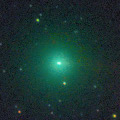
|
It approached to the sun down to 0.88 A.U. in mid April, and it brightened up to 8.6 mag (Apr. 13, Juan Jose Gonzalez). Now it is fading, but it is still bright as 9.6 mag (May 4, Chris Wyatt). It keeps 9-10 mag until mid May. It keeps observable until it fades out, although it keeps locating somewhat low in the morning sky.
Date(TT) R.A. (2000) Decl. Delta r Elong. m1 Best Time(A, h)
May 7 23 43.20 10 18.2 1.292 0.948 46 10.5 3:28 (268, 15)
May 14 0 8.20 11 51.8 1.366 1.001 46 11.2 3:20 (265, 14)
|
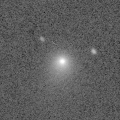
|
Now it is 10.9 mag (May 4, Chris Wyatt). It is expected to keep so bright as 6-8 mag for a long time from 2011 to 2012, and to be observable in good condition in the Northern Hemisphere. Now it locates high in the Southern Hemisphere. It is also appearing in the morning sky in the Northern Hemisphere.
Date(TT) R.A. (2000) Decl. Delta r Elong. m1 Best Time(A, h)
May 7 22 59.27 -8 50.0 3.615 3.289 63 11.0 3:28 (290, 12)
May 14 23 0.84 -7 37.5 3.436 3.220 69 10.8 3:20 (292, 16)
|
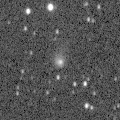
|
Now it is bright and visible visually at 13.3 mag (May 4, Chris Wyatt). It keeps bright as 13-14 mag for a long time after this until 2013. It is not observable in the Northern Hemisphere, but it is observable in good condition in the Southern Hemisphere.
Date(TT) R.A. (2000) Decl. Delta r Elong. m1 Best Time(A, h)
May 7 14 22.72 -82 38.0 5.246 5.730 113 13.6 23:20 ( 0,-28)
May 14 13 35.89 -82 51.5 5.216 5.714 114 13.5 22:05 ( 0,-28)
|

|
Tiny short periodic comet. Now it locates very close to the Sun, only 0.5 A.U. from the Sun. It was expected to be 17 mag at best originally, because its brightness behaves similar to an asteroid. But actually, it became so bright as 12.8 mag (Apr. 15, Chris Wyatt). It was 9 mag in the STEREO satellite images in early April. However, it will never be observable again in this apparition.
Date(TT) R.A. (2000) Decl. Delta r Elong. m1 Best Time(A, h)
May 7 1 50.47 14 24.6 1.591 0.674 15 13.8 3:28 (246, -8)
May 14 2 22.51 16 45.7 1.709 0.769 14 14.8 3:20 (242, -9)
|

|
Now it is bright as 11.3 mag and visible visually (Apr. 27, Juan Jose Gonzalez).
Date(TT) R.A. (2000) Decl. Delta r Elong. m1 Best Time(A, h)
May 7 10 41.57 1 36.2 5.759 6.255 115 13.8 20:25 ( 19, 55)
May 14 10 41.65 1 38.9 5.861 6.255 108 13.8 20:33 ( 33, 52)
|

|
First return of a new periodic comet which brightened up to 13 mag in a major outburst in 2005. When appearing in the morning sky in early April, it was unexpectedly bright as 14.3 mag (Apr. 5, Hidetaka Sato). It keeps bright after that, as 14.3 mag (Apr. 15, Hidetaka Sato). It will be getting higher gradually after this, and will be observable in an excellent condition from summer to winter. It may be visible at 13 mag again. However, if it has just brightened temporarily in outburst, it may fade out very rapidly.
Date(TT) R.A. (2000) Decl. Delta r Elong. m1 Best Time(A, h)
May 7 22 5.88 -13 54.9 2.123 2.143 77 14.1 3:28 (303, 19)
May 14 22 16.97 -12 28.0 2.045 2.136 81 13.9 3:20 (303, 21)
|
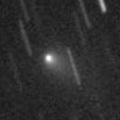
|
Now it is 13.2 mag and visible visually (Apr. 26, Juan Jose Gonzalez). It will brighten up to 12 mag in autumn. In the Northern Hemisphere, it keeps observable for a long time until 2012 spring. In the Southern Hemisphere, it is not observable until November. A small outburst occured and it brightened by 2 mag on 2010 Aug. 31 (Bernhard Haeusler). Recent brightening is somewhat slower than expected.
Date(TT) R.A. (2000) Decl. Delta r Elong. m1 Best Time(A, h)
May 7 20 2.77 84 54.3 2.491 2.426 74 14.1 3:28 (183, 40)
May 14 22 57.53 88 17.1 2.512 2.380 70 14.0 3:20 (182, 36)
|
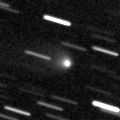
|
Now it is 15.2 mag (Apr. 9, Katsumi Yoshimoto). It will be observable at 13-14 mag for a long time from 2011 to 2012.
Date(TT) R.A. (2000) Decl. Delta r Elong. m1 Best Time(A, h)
May 7 20 21.30 -4 47.0 5.505 5.753 99 14.4 3:28 (320, 42)
May 14 20 17.39 -4 42.4 5.358 5.729 106 14.3 3:20 (326, 45)
|
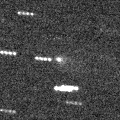
|
Now it is 14.9 mag (Apr. 29, Artyom Novichonok). It will be fading after this. The condition in this apparition is bad. It locates high in the Southern Hemisphere, however, it keeps extremely low until May in the Northern Hemisphere.
Date(TT) R.A. (2000) Decl. Delta r Elong. m1 Best Time(A, h)
May 7 23 4.68 -15 9.4 2.063 1.872 64 14.4 3:28 (294, 7)
May 14 23 17.74 -14 21.4 2.036 1.910 68 14.6 3:20 (294, 9)
|

|
Big asteroid discovered in 1906. It suddenly showed the cometary activity on Dec. 11, probably due to an impact of a small object. It was very bright as 11.5 mag visually (Dec. 17, Juan Jose Gonzalez). It had a dust coma still on Jan. 9 (Joseph Brimacombe). Now it is stellar at 13.8 mag (Apr. 5, Juan Jose Gonzalez).
Date(TT) R.A. (2000) Decl. Delta r Elong. m1 Best Time(A, h)
May 7 9 16.49 31 43.4 2.764 2.875 85 14.4 20:25 ( 92, 63)
May 14 9 22.56 30 49.3 2.843 2.864 80 14.5 20:33 ( 94, 57)
|
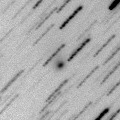
|
It reached up to 13.3 mag, much brighter than originally expected, and visible visually (Jan. 24, Juan Jose Gonzalez). Now it is fading slowly, but still bright as 14.2 mag (May 3, Hiroshi Abe). It will be higher after this, and observable at 15 mag in good condition until autumn.
Date(TT) R.A. (2000) Decl. Delta r Elong. m1 Best Time(A, h)
May 7 23 42.60 15 18.3 3.335 2.731 45 14.9 3:28 (263, 17)
May 14 23 46.98 14 31.4 3.277 2.760 51 14.9 3:20 (266, 20)
|
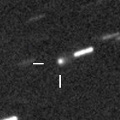
|
It will approach to the sun down to 0.5 A.U. in September, and it is expected to brighten up to 6 mag. Now it is 13.7 mag and visible visually (Apr. 26, Juan Jose Gonzalez). In the Southern Hemisphere, it keeps observable until early September when it becomes 7 mag. In the Northern Hemisphere, it becomes unobservable in August. But after appearing in the morning sky in October, it becomes observable in the excellent condition at midnight.
Date(TT) R.A. (2000) Decl. Delta r Elong. m1 Best Time(A, h)
May 7 10 33.68 7 29.6 1.827 2.387 111 15.1 20:25 ( 26, 60)
May 14 10 29.96 7 53.0 1.829 2.287 103 14.9 20:33 ( 43, 56)
|
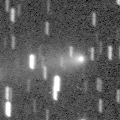
|
It reached up to 14.0 mag and became visible visually in December (Dec. 17, Juan Jose Gonzalez). Then it has been fading, and faded down to 18.3 mag on Mar. 31 (Yasukazu Ikari). However, it brightened up to 16 mag in outburst on Apr. 5. Then it keeps brightening and reached up to 14.7 mag now (May 6, Hidetaka Sato). It locates low in the Southern Hemisphere. It will be getting lower gradually after this in the Northern Hemisphere.
Date(TT) R.A. (2000) Decl. Delta r Elong. m1 Best Time(A, h)
May 7 7 55.40 40 16.1 2.871 2.668 68 15.0 20:25 (113, 49)
May 14 8 8.07 39 33.0 2.974 2.697 64 15.3 20:33 (114, 45)
|
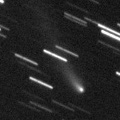
|
It reached up to 13.5 mag and visible visually in winter (Feb. 4, Juan Jose Gonzalez). Now it is fading, but still bright as 15.3 mag (Apr. 23, Artyom Novichonok). In the Southern Hemisphere, it becomes low temporarily in May and June, but it keeps observable for a long time. It will never be observable again in the Northern Hemisphere.
Date(TT) R.A. (2000) Decl. Delta r Elong. m1 Best Time(A, h)
May 7 4 52.37 -20 9.4 3.673 3.073 46 15.7 20:25 ( 77,-18)
May 14 4 57.35 -20 52.8 3.711 3.093 45 15.7 20:33 ( 81,-24)
|
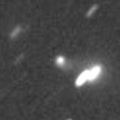
|
Now it is 16.0 mag (Apr. 3, M. Jaeger, E. Prosperi, S. Prosperi, W. Vollmann). It keeps 15 mag from 2011 summer to 2012 summer. But it is not observable around the perihelion. It is observable in good condition in the Northern Hemisphere in 2011, and in the Southern Hemisphere in 2012.
Date(TT) R.A. (2000) Decl. Delta r Elong. m1 Best Time(A, h)
May 7 13 14.58 27 50.7 2.632 3.364 129 15.9 22:14 ( 0, 83)
May 14 13 11.77 27 41.5 2.638 3.313 124 15.8 21:44 ( 0, 83)
|
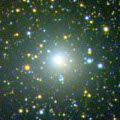
|
It reached up to 7.7 mag in 2009 summer (2009 Aug. 13, Chris Wyatt). Now it is fading, but still bright as 13.9 mag (Mar. 29, Artyom Novichonok). It will never be observable again in the Northern Hemisphere. In the Southern Hemisphere, it keeps observable in good condition until 2011 autumn when it becomes fainter than 18 mag.
Date(TT) R.A. (2000) Decl. Delta r Elong. m1 Best Time(A, h)
May 7 17 43.34 -63 42.0 6.062 6.689 124 15.9 2:47 ( 0, -9)
May 14 17 31.85 -64 21.6 6.053 6.737 129 15.9 2:09 ( 0, -9)
|
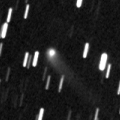
|
Now it is 15.6 mag (May 8, Tzec Maun Observatory). It will be fading very slowly after this. In the Northern Hemisphere, it keeps observable for a long time until 2012 spring when it fades down to 17-18 mag. It will not be observable in the Southern Hemisphere.
Date(TT) R.A. (2000) Decl. Delta r Elong. m1 Best Time(A, h)
May 7 22 24.88 44 34.5 5.231 4.846 62 15.9 3:28 (239, 44)
May 14 22 31.07 45 31.0 5.209 4.867 64 16.0 3:20 (238, 46)
|
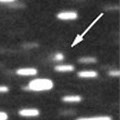
|
Now it is 16.0 mag (Apr. 26, Artyom Novichonok). It keeps 16 mag for a while. In the Northern Hemisphere, it will be getting lower gradually after this, and it will be unobservable in July . In the Southern Hemisphere, it keeps locating low.
Date(TT) R.A. (2000) Decl. Delta r Elong. m1 Best Time(A, h)
May 7 7 3.94 35 41.9 2.533 2.178 58 16.1 20:25 (111, 38)
May 14 7 20.22 35 2.3 2.582 2.167 55 16.0 20:33 (112, 34)
|
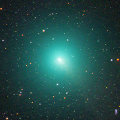
|
It approached to the earth down to 0.12 A.U. and brightened up to 4.6 mag in October (Oct. 18, Juan Jose Gonzalez). It was very large, double of the full moon, and very bright, visible with naked eyes. Now it is fading. It has already faded down to 14.9 mag (Apr. 23, Artyom Novichonok). It will be getting lower after this, and will be unobservable in June.
Date(TT) R.A. (2000) Decl. Delta r Elong. m1 Best Time(A, h)
May 7 8 35.15 5 14.8 2.352 2.460 84 16.3 20:25 ( 62, 41)
May 14 8 44.79 5 13.9 2.493 2.518 79 16.5 20:33 ( 68, 36)
|

|
It had been bright as 13-14 mag for a long time from 2007 to 2009. Now it is fading slowly, but it is still bright as 16.1 mag (Apr. 28, Artyom Novichonok). It is observable in good condition in the Northern Hemisphere. It locates low in the Southern Hemisphere.
Date(TT) R.A. (2000) Decl. Delta r Elong. m1 Best Time(A, h)
May 7 10 38.76 41 43.0 9.762 9.939 97 16.5 20:25 (130, 79)
May 14 10 36.48 41 23.7 9.903 9.975 91 16.5 20:33 (117, 72)
|

|
It is expected to keep 14-15 mag for a long time from 2011 summer to 2012 summer. The condition is good in the Southern Hemisphere, and it keeps observable for a long time. In the Northern Hemisphere, it is observable in the low sky in 2011 spring. But after that, it is not observable until 2012 August. However, this comet was observed only during two days in 2010 June. So the orbital elements are extremely uncertain.
Date(TT) R.A. (2000) Decl. Delta r Elong. m1 Best Time(A, h)
May 7 18 27.14 -33 14.8 3.037 3.760 129 16.7 3:28 ( 0, 22)
May 14 18 22.32 -34 56.2 2.904 3.705 136 16.5 2:58 ( 0, 20)
|
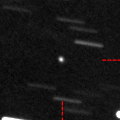
|
It is expected to be bright as 9 mag from 2012 to 2013. Now it is 16.6 mag (Apr. 28, P. Dupouy). In the Northern Hemisphere, it keeps observable in good condition for a long time until 2012 autumn when the comet brightens up to 10 mag. In the Southern Hemisphere, it is hardly observble before the perihelion passage. But it becomes observable in good condition since 2013 after the perihelion passage.
Date(TT) R.A. (2000) Decl. Delta r Elong. m1 Best Time(A, h)
May 7 11 36.10 65 41.8 6.515 6.589 89 16.8 20:36 (180, 59)
May 14 11 33.19 65 1.9 6.524 6.532 86 16.7 20:33 (174, 60)
|
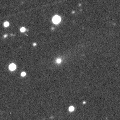
|
Now it is 17.7 mag (Mar. 7, W. Hasubick). It was observed around 16 mag in 2009 and 2010. In 2011, it keeps observable at 17 mag from spring to autumn. It locates somewhat low in the Northern Hemisphere.
Date(TT) R.A. (2000) Decl. Delta r Elong. m1 Best Time(A, h)
May 7 17 37.04 -23 9.3 3.263 4.099 141 16.8 2:40 ( 0, 32)
May 14 17 33.97 -23 14.7 3.210 4.108 148 16.8 2:10 ( 0, 32)
|
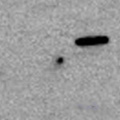
|
Now it is 16.8 mag (Apr. 26, Hidetaka Sato). It brightens up to 12 mag in autumn. But the condition is bad. In the Northern Hemisphere, the altitude will be lower than 20 degree in June when it brightens up to 15 mag, then it will be unobservable in August. After the perihelion passage, it is only observable from December to February in the evening very low sky. In the Southern Hemisphere, it keeps observable for a long time, although it keeps locating extremely low.
Date(TT) R.A. (2000) Decl. Delta r Elong. m1 Best Time(A, h)
May 7 8 53.54 29 48.7 2.116 2.209 81 17.0 20:25 ( 91, 58)
May 14 8 59.50 28 56.7 2.145 2.148 76 16.8 20:33 ( 94, 52)
|
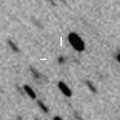
|
Now it is 17.5 mag (May 2, C. Rinner, F. Kugel). It will brighten up to 16 mag from summer to autumn, and will be observable in good condition.
Date(TT) R.A. (2000) Decl. Delta r Elong. m1 Best Time(A, h)
May 7 16 38.72 -4 44.1 1.474 2.410 151 17.1 1:42 ( 0, 50)
May 14 16 35.94 -3 50.1 1.419 2.380 156 16.9 1:12 ( 0, 51)
|
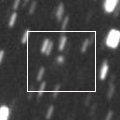
|
Now it is 16.9 mag (Apr. 27, Artyom Novichonok). In the Northern Hemisphere, it keeps observable at 17 mag in good condition until summer. It locates low in the Southern Hemisphere.
Date(TT) R.A. (2000) Decl. Delta r Elong. m1 Best Time(A, h)
May 7 17 1.33 39 26.4 3.568 4.119 116 17.1 2:05 (180, 86)
May 14 16 45.92 40 44.3 3.571 4.137 117 17.1 1:22 (180, 84)
|

|
Now it is 17.0 mag (Apr. 10, E. Bryssinck). It will brighten up to 13 mag in next winter. But the condition of this apparition is bad, and it will not be observable around the perihelion passage. It will be observable until July when it brightens up to 16 mag in the Northern Hemisphere, or until September when it brightens up to 15 mag in the Southern Hemisphere.
Date(TT) R.A. (2000) Decl. Delta r Elong. m1 Best Time(A, h)
May 7 10 19.16 21 48.0 2.065 2.487 102 17.2 20:25 ( 51, 71)
May 14 10 21.68 20 58.8 2.114 2.448 96 17.2 20:33 ( 63, 64)
|

|
Now it is 17.5 mag (May 8, Hidetaka Sato). It will brighten rapidly, and will be observable at 15 mag in good condition from July to October. It locates somewhat low in the Northern Hemisphere.
Date(TT) R.A. (2000) Decl. Delta r Elong. m1 Best Time(A, h)
May 7 20 19.14 -14 36.9 2.084 2.501 102 17.5 3:28 (326, 34)
May 14 20 25.59 -14 36.4 1.985 2.483 107 17.2 3:20 (330, 35)
|

|
Now it is 17.3 mag (May 3, C. Rinner, F. Kugel). It will be observable in good condition at 17.5 mag in 2011 spring in the Southern Hemisphere, and at 17 mag in next winter in the Northern Hemisphere.
Date(TT) R.A. (2000) Decl. Delta r Elong. m1 Best Time(A, h)
May 7 12 21.59 -26 46.7 1.760 2.639 143 17.4 21:20 ( 0, 28)
May 14 11 59.11 -22 43.9 1.801 2.595 132 17.4 20:33 ( 1, 32)
|
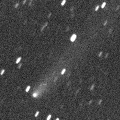
|
It was observed as bright as 13.0 mag in last autumn (Sept. 25, Ken-ichi Kadota). Now it is fading. It has already faded down to 16.8 mag (Apr. 26, Artyom Novichonok). It will be fainter than 18 mag in May.
Date(TT) R.A. (2000) Decl. Delta r Elong. m1 Best Time(A, h)
May 7 12 22.76 -20 16.2 2.253 3.126 144 17.7 21:23 ( 0, 35)
May 14 12 20.74 -19 14.5 2.349 3.168 137 17.9 20:53 ( 0, 36)
|
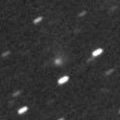
|
Now it is 17.4 mag (May 7, Hidetaka Sato). It is fading slowly. In the Northern Hemisphere, it keeps observable in good condition until 2011 summer. It is not observable in the Southern Hemisphere.
Date(TT) R.A. (2000) Decl. Delta r Elong. m1 Best Time(A, h)
May 7 16 59.21 48 18.8 5.227 5.641 109 17.7 2:03 (180, 77)
May 14 16 50.97 48 10.2 5.236 5.669 110 17.7 1:27 (180, 77)
|

|
Now it is 17.1 mag (May 8, Hidetaka Sato). It will be observable at 17 mag in good condition from summer to autumn.
Date(TT) R.A. (2000) Decl. Delta r Elong. m1 Best Time(A, h)
May 7 21 47.82 -16 51.8 2.013 2.130 82 17.9 3:28 (308, 19)
May 14 22 0.17 -16 16.5 1.933 2.122 86 17.8 3:20 (309, 21)
|
|
![]()
 29P/Schwassmann-Wachmann 1
29P/Schwassmann-Wachmann 1 213P/2009 B3 ( Van Ness )
213P/2009 B3 ( Van Ness ) C/2010 G2 ( Hill )
C/2010 G2 ( Hill ) C/2006 S3 ( LONEOS )
C/2006 S3 ( LONEOS ) 9P/Tempel 1
9P/Tempel 1 (596) Scheila
(596) Scheila C/2009 Y1 ( Catalina )
C/2009 Y1 ( Catalina ) C/2010 X1 ( Elenin )
C/2010 X1 ( Elenin ) 240P/2010 P1 ( NEAT )
240P/2010 P1 ( NEAT ) C/2010 B1 ( Cardinal )
C/2010 B1 ( Cardinal ) C/2011 A3 ( Gibbs )
C/2011 A3 ( Gibbs ) C/2006 W3 ( Christensen )
C/2006 W3 ( Christensen ) C/2008 FK75 ( Lemmon-Siding Spring )
C/2008 FK75 ( Lemmon-Siding Spring ) 123P/West-Hartley
123P/West-Hartley 103P/Hartley 2
103P/Hartley 2 C/2005 L3 ( McNaught )
C/2005 L3 ( McNaught ) C/2010 M1 ( Gibbs )
C/2010 M1 ( Gibbs ) C/2011 F1 ( LINEAR )
C/2011 F1 ( LINEAR ) 74P/Smirnova-Chernykh
74P/Smirnova-Chernykh 73P/Schwassmann-Wachmann 3
73P/Schwassmann-Wachmann 3 115P/Maury
115P/Maury C/2009 UG89 ( Lemmon )
C/2009 UG89 ( Lemmon ) 71P/Clark
71P/Clark 48P/Johnson
48P/Johnson C/2011 G1 ( McNaught )
C/2011 G1 ( McNaught ) 43P/Wolf-Harrington
43P/Wolf-Harrington C/2007 VO53 ( Spacewatch )
C/2007 VO53 ( Spacewatch ) 130P/McNaught-Hughes
130P/McNaught-Hughes![]()

























